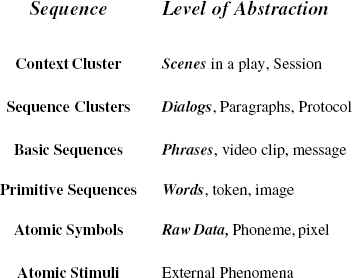7.4. CRA III: The Inference Hierarchy
The phases of inference from observation to action show the flow of inference, a top-down view of how cognition is implemented algorithmically. The inference hierarchy is the part of the algorithm architecture that organizes the data structures. Inference hierarchies have been in use since Hearsay II in the 1970s, but the CR hierarchy is unique in its method of integrating machine learning with real-time performance during the wake epochs. An illustrative inference hierarchy includes layers from atomic stimuli at the bottom to information clusters that define action contexts as in Figure 7.5.
Figure 7.5. Standard inference hierarchy. © Dr. Joseph Mitola III, used with permission

The pattern of accumulating elements into sequences begins at the bottom of the hierarchy. Atomic stimuli originate in the external environment including RF, acoustic, image and location domains among others. The atomic symbols extracted from them are the most primitive symbolic units in the domain. In speech, the most primitive elements are the phonemes. In the exchange of textual data (e.g., in email), the symbols are the typed characters. In images, the atomic symbols may be the individual picture elements (pixels) or they may be small groups of pixels with similar hue, intensity, texture, etc.
A related set of atomic symbols forms a primitive sequence. Words in ...
Get Cognitive Networks: Towards Self-Aware Networks now with the O’Reilly learning platform.
O’Reilly members experience books, live events, courses curated by job role, and more from O’Reilly and nearly 200 top publishers.

